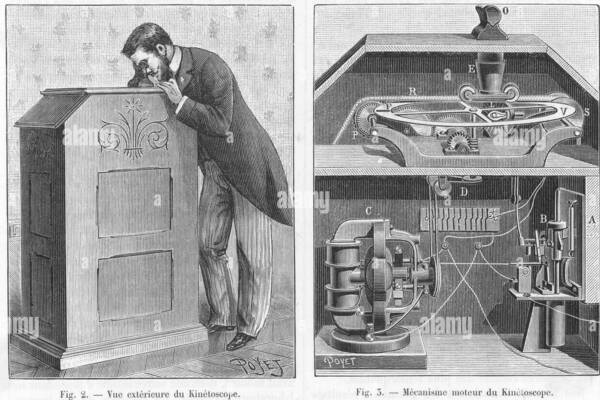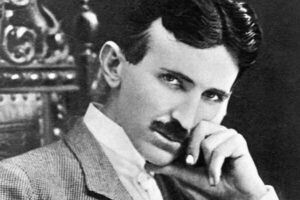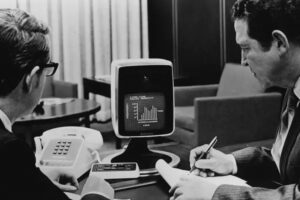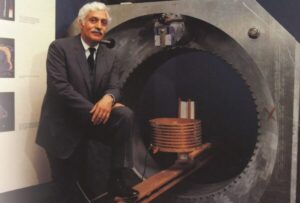The Kinetoscope, invented by Thomas Edison, was a groundbreaking invention that revolutionized the world of film and entertainment. This article aims to provide an overview of this revolutionary invention and explore its fascinating history.
The importance of the Kinetoscope in the evolution of film and entertainment cannot be overstated. It played a pivotal role in shaping the world of cinema as we know it today. By delving into the world of Edison’s Cylinder, we can gain a deeper appreciation for the technological advancements it brought forth.
Table of Contents
Evolution of Film Projection
Before the advent of modern digital projectors and streaming services, early film projection methods paved the way for the mesmerizing world of the Kinetoscope. These early methods, which included simple devices like the Zoetrope and the Phenakistoscope, were rudimentary but groundbreaking in their own right.
However, it was Thomas Edison’s revolutionary invention, the Kinetoscope, that truly transformed the world of film projection. Introduced in the late 19th century, this innovative device was an outstanding breakthrough in film technology. It used celluloid motion picture film and allowed individuals to view moving images through a single viewer. The Kinetoscope completely revolutionized the motion picture industry, laying the foundation for the cinematic advancements we enjoy today.
As the Kinetoscope burst onto the scene, it faced stiff competition from other contemporary inventions. One of its notable rivals was the Lumière brothers’ Cinématographe, which combined a camera, printer, and projector in one apparatus. The Kinetoscope, on the other hand, primarily focused on projecting moving images to a single viewer. This distinction made the Kinetoscope unique and offered a new perspective on film projection compared to its counterparts.
The impact of the Kinetoscope on film technology was profound. Its ability to capture and project moving images set the stage for subsequent advancements in the field. Films produced with the Kinetoscope showcased a mesmerizing blend of art and technology, captivating audiences like never before. The Kinetoscope was not only an entertainment medium but also an innovation that symbolized the remarkable progress of the film industry.
The Mechanics of Edison’s Cylinder
The Kinetoscope, invented by Thomas Edison, revolutionized the world of film and entertainment. This section will delve into the mechanics of this remarkable invention, discussing how it works, its key components, and the technological advancements it introduced.
The Kinetoscope operates through a combination of intricate mechanisms and optical illusions. At its core is a rotating cylinder, embedded with vertical rows of images captured on celluloid film. As the cylinder rotates, a series of lenses combined with a light source illuminates the images, creating a moving picture.
The key components of the Kinetoscope include the cylinder itself, a strong light source, a system of lenses, and a viewing apparatus equipped with a magnifying eyepiece. The cylinder is carefully designed to hold and present the film in a way that allows for seamless viewing. The light source, often an electric lamp or gas-powered flame, ensures that the images are adequately illuminated.
The technological advancements introduced by the Kinetoscope were groundbreaking at the time. One of the notable advancements was the use of celluloid film in a continuous loop, allowing for the projection of longer sequences. This innovation significantly extended the viewing time, enhancing the immersive and captivating experience for the audience.
Furthermore, the Kinetoscope pioneered the concept of motion pictures, introducing a form of entertainment that captivated audiences like never before. By capturing and projecting a series of images in quick succession, it created an illusion of movement, bringing still photographs to life.
The impact of Edison’s Cylinder and the Kinetoscope on the field of film cannot be overstated. It paved the way for the development of cinema as we know it today. The mechanics of the Kinetoscope, with its carefully engineered components and innovative use of technology, laid the foundation for future advancements in film projection and storytelling techniques.
In conclusion, the Kinetoscope, with its intricate mechanisms and technological innovations, marked a significant turning point in the history of film. It provided a mesmerizing viewing experience, captivating audiences and inspiring future generations of filmmakers. The mechanics of Edison’s Cylinder and the Kinetoscope not only offered a glimpse into the possibilities of moving pictures but also propelled the entertainment industry into a new era.
Popularizing the Kinetoscope
Edison’s strategy to market and promote the Kinetoscope
Edison, being the brilliant inventor that he was, understood the importance of effectively marketing his creation, the Kinetoscope. To introduce this revolutionary invention to the masses, he employed various marketing strategies that captured the attention of the public.
One of the key strategies employed by Edison was to demonstrate the Kinetoscope in public exhibitions and fairs. These exhibitions showcased the magic of moving images and allowed people to experience the wondrous world that the Kinetoscope offered. By allowing people to witness the magic themselves, Edison created a sense of intrigue and wonder that piqued the interest of the masses.
Additionally, Edison was well aware of the power of publicity in driving public interest. He used newspapers and other forms of media to spread the word about the Kinestoscope, highlighting its capabilities and capturing the imagination of the people. By creating a sense of exclusivity and anticipation, Edison generated the desire among the public to experience this new form of entertainment for themselves.
Reception among the masses and impact on popular culture
The reception of the Kinetoscope among the masses was nothing short of phenomenal. People were mesmerized by the moving images displayed through this invention. The Kinetoscope quickly became a cultural phenomenon, captivating the attention of people from all walks of life.
Aside from its entertainment value, the Kinetoscope had a profound impact on shaping popular culture. It introduced a new form of visual storytelling that allowed people to experience narratives in a whole new way. This medium quickly became a popular pastime, with people flocking to Kinetoscope parlors to immerse themselves in this new form of enchanting amusement.
Examples of successful Kinetoscope parlors and their significance
One of the most successful Kinetoscope parlors was located in New York City. This parlor, often referred to as the “Penny Arcade”, attracted a massive crowd on a daily basis. It became a hotspot for both locals and tourists who wanted to experience the magic of motion pictures. The Penny Arcade was a place where people could gather and have a collective awe-inspiring experience.
Another successful Kinetoscope parlor was established in London, bringing the wonders of the Kinetoscope to an international audience. This parlor became a significant cultural hub, showcasing the latest films captured on Edison’s Cylinder and sparking a renewed interest in the art of visual storytelling.
These successful Kinetoscope parlors served as pioneering establishments that paved the way for the future of cinema. They not only provided entertainment but also cultivated a new form of artistic expression. The significance of these parlors cannot be overstated, as they played a crucial role in popularizing the Kinetoscope and setting the stage for the evolution of film as we know it today.
In conclusion, Edison’s strategy to market and promote the Kinetoscope, coupled with its reception among the masses and impact on popular culture, played a pivotal role in the success and legacy of this groundbreaking invention. The Kinetoscope revolutionized the entertainment industry, captivating audiences and paving the way for modern cinema. Its influence can still be felt today, reminding us of the endless possibilities that arise from the innovative spirit of inventors like Thomas Edison.
The Forgotten Gems: Movies on Edison’s Cylinder
The world of early cinema is filled with hidden treasures, and Edison’s Cylinder holds some of the most remarkable ones. This section will explore some of the noteworthy films produced for the Kinetoscope, shedding light on their historical significance and the storytelling techniques employed.
One such film is “The Great Train Robbery”, a groundbreaking narrative that captivated audiences with its thrilling depiction of a train robbery. This film, directed by Edwin S. Porter, showcased the potential of the Kinetoscope as a medium for storytelling. With its dynamic editing, innovative use of intertitles, and intense action sequences, “The Great Train Robbery” set a new standard for cinematic storytelling.
Another noteworthy film from the era is “The Kiss”, directed by William Heise. This short film captured a simple yet powerful moment between two characters, showing a couple sharing a passionate kiss. While it may seem commonplace today, at the time, scenes like this were revolutionary. “The Kiss” exemplifies how filmmakers began to explore the potential of the Kinetoscope as a tool for capturing and conveying human emotions.
Preserving these early films has been a challenging task due to the fragility of the original Edison’s Cylinder format. However, dedicated preservation and restoration efforts have been made to ensure that these gems are not lost to history. Institutions such as the Library of Congress and the Museum of Modern Art have undertaken initiatives to digitally restore and preserve these films, allowing future generations to appreciate the artistry and innovation of early cinema.
In conclusion, the films produced for the Kinetoscope are truly the forgotten gems of the cinematic world. These early works paved the way for the storytelling techniques and artistic expression we see in modern cinema today. Through preservation and restoration efforts, we can continue to explore and appreciate the rich history and impact of these films captured on Edison’s Cylinder.
Legacy and Influence of the Kinetoscope
The Kinetoscope, Thomas Edison’s revolutionary invention, has left an undeniable impact on the world of cinema. Its development marked a pivotal moment in the history of film and entertainment, paving the way for modern cinema as we know it. The Kinetoscope’s influence can still be seen today in the ways movies are made and enjoyed.
One of the key legacies of the Kinetoscope is its influence on subsequent film inventions and technology. This groundbreaking device introduced the concept of motion pictures and propelled the development of film projection methods. Its success inspired other inventors to explore new possibilities and improve upon Edison’s creation. The Kinetoscope laid the foundation for advancements such as the development of film projectors, which allowed movies to be projected onto larger screens for mass viewing.
Beyond its technological influence, the Kinetoscope continues to hold relevance in the entertainment industry today. The concept of motion pictures captured the imagination of the masses and sparked the growth of a global film culture. The Kinetoscope’s initial success led to the establishment of numerous Kinetoscope parlors, where people could gather to watch these early films. This new form of communal entertainment transformed the way people experienced and consumed visual media.
The Kinetoscope’s impact on the entertainment industry is undeniable, as it popularized the concept of storytelling through film. While the early films captured on Edison’s Cylinder may seem primitive by today’s standards, they marked the beginning of a new era in storytelling. Filmmakers started experimenting with different techniques and approaches, building upon the foundation laid by the Kinetoscope. From early narrative films to elaborate cinematic masterpieces, the influence of the Kinetoscope can be seen in the rich tapestry of movies created over the years.
In conclusion, the Kinetoscope’s legacy as the precursor to modern cinema cannot be overstated. Its advancements in film technology and the popularity it garnered among the masses laid the groundwork for the development of the film industry as we know it today. The Kinetoscope paved the way for modern cinema, influencing subsequent film inventions, and leaving an indelible mark on the entertainment industry. Its continued relevance and impact serve as a testament to the brilliance of Thomas Edison’s innovation and its lasting legacy in film history.
Conclusion
In conclusion, Thomas Edison’s Cylinder and the Kinetoscope were not only revolutionary inventions but also significant milestones in the history of film and entertainment. The Kinetoscope introduced a new era of film projection, surpassing earlier methods and captivating audiences with its mesmerizing visuals. Its impact on film technology cannot be overstated, as it brought about pivotal advancements that continue to shape the industry today.
The significance of Edison’s Cylinder and the Kinetoscope lies not only in their technological advancements but also in their popularization. Edison’s strategic marketing and promotional efforts successfully brought the Kinetoscope to the masses, leading to its widespread reception and incorporation into popular culture. The establishment of Kinetoscope parlors further solidified its importance, creating spaces specifically designed for experiencing the wonders of early film.
While the Kinetoscope itself is widely recognized for its contributions to film history, its films captured on the Edison Cylinder are often overlooked. These forgotten gems showcase early storytelling techniques and provide valuable insights into the evolution of cinema. Efforts to preserve and restore these films highlight their cultural and historical significance, ensuring that future generations can appreciate their cinematic brilliance.
The legacy and influence of the Kinetoscope are undeniable. By paving the way for modern cinema, it sparked a chain of innovations and inventions that continue to shape the entertainment industry. From the introduction of synchronized sound to the development of digital projection, the impact of the Kinetoscope resonates through time. Its lasting legacy is a testament to the power of innovation and the profound influence that Edison and his invention have had on film history.
In appreciation of the technological advancements offered by the Kinetoscope, we must recognize the pivotal role it played in transforming film and entertainment. It not only provided a medium for storytelling but also revolutionized the way films were projected and experienced. The Kinetoscope opened up a wondrous world of possibilities, captivating audiences then and continuing to shape the landscape of cinema today.
In conclusion, the significance of Edison’s Cylinder and the Kinetoscope cannot be overstated. Their impact on film technology, popular culture, and storytelling techniques has left an indelible mark on the history of cinema. We owe a great deal to these inventions for shaping the way we consume and appreciate films. The legacy of the Kinetoscope serves as an everlasting reminder of the advancements achieved by Thomas Edison and their enduring impact on the entertainment industry.





